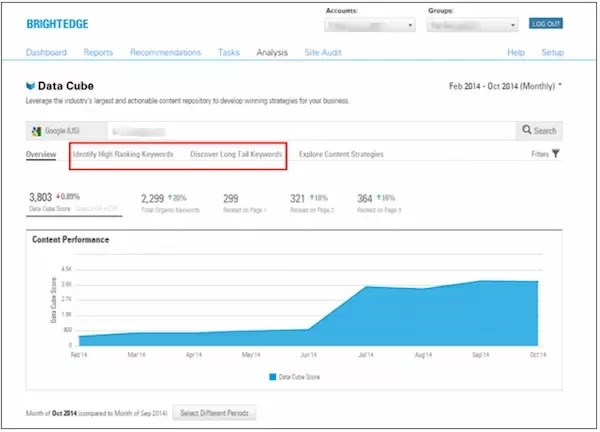Keyword research and discovery is the fundamental first step towards optimizing your website content so it ranks for keywords, captures organic search share and generates leads. When conducting keyword research, it may be tempting to focus on those highly competitive one- or two-word terms used by most in your industry’s vertical. While these terms definitely should be part of your long-term SEO content keyword strategy, they should also be balanced with less competitive, “long-tail” keywords built into your site’s content. Long-tail keywords are more likely to capture searchers’ specific intent – yielding greater search visibility for your optimized content and higher conversions. I explain the rationale behind using long-tail keywords in another post on the BrightEdge blog:
Marketers spend a lot of time dreaming up the perfect piece of content, and then try to incorporate keywords. To be more effective and use your content to its potential, this strategizing should really be done the other way around. Research long-tailed keywords first, and incorporate them from the beginning of the process, so that your content is shaped around the keywords you need to use. Deciding on which long-tailed keywords to use before producing the content helps to ensure that the content gets seen by the right audience.
So, creating site content with long-tail keywords “baked in” signals search engines that your content is most relevant to your target user’s query, creating greater search visibility and conversions. In this post, we’ll go over si simple ways to discover long-tail keywords.
Resources for long-tail keyword research
1. The BrightEdge Data Cube
If you have access to the huge repository of data stored in our Data Cube, then you’re already a step or three ahead of your competitors in accessing competitive long-tail keywords. By leveraging its “SEO X-Ray” technology (similar to a search engine with a massive data bank of keywords from all the major search engines around the globe), you can readily view your competitors’ SEO management and strategies, including the keywords that are generating results for them that you should pursue as well. Specific to long-tail keywords, you can use the BrightEdge platform for keyword discovery by entering your site’s Web address (URL) in its search box, followed by those of your competitors. This will give you not only a list of long-tail keywords and their respective search performance, but also invaluable competitive intelligence. (Refer to my guide on performing keyword research, noted above, for more details on leveraging the BrightEdge Data Cube). 
2. Google trends
Google Trends and its related searches feature are free Google resources that give insight into how any given keyword is trending on the Web in terms of search volume, as well as related searches that, when explored, can offer more long-tail keyword terms to add to your keyword portfolio. Google’s 2012 U.S. presidential election example illustrates the data you can glean:  Looking at Google’s example, you’ll notice “top” and “rising” stats. Top searches represent the popular search terms similar to the keyword term entered. The “rising” percentages are those searches related to your original keyword term that have shown a significant growth in popularity over a time period that you specify (such as month-over-month). Also notable are the “breakout” terms reflected in the election example (which, in this example, indicate the related search terms experienced a search query growth of more than 5,000 percent over the specified time period). In this way, Google Trends and its related searches can help you optimize for long-tail keyword terms that are immediately relevant, and those that are trending in organic search.
Looking at Google’s example, you’ll notice “top” and “rising” stats. Top searches represent the popular search terms similar to the keyword term entered. The “rising” percentages are those searches related to your original keyword term that have shown a significant growth in popularity over a time period that you specify (such as month-over-month). Also notable are the “breakout” terms reflected in the election example (which, in this example, indicate the related search terms experienced a search query growth of more than 5,000 percent over the specified time period). In this way, Google Trends and its related searches can help you optimize for long-tail keyword terms that are immediately relevant, and those that are trending in organic search.
3. Google Webmaster Tools (GWT)
Using GWT search queries, you can see the top search queries that return your site pages in Google SERPs. You can also glean insights into your site’s content performance within a set time period of up to 90 days with parameters that include comparative page impressions and click-through rates (CTR). Google provides a video describing its search queries function, here: Note: The 90-day limit on GWT’s historical keyword data can be problematic when creating an informed, long-term keyword strategy. I discuss how the BrightEdge SEO platform solves this analytical gap further on the BrightEdge blog.
4. Google Ads keyword planner
For culling data on long-term keywords, you can also set up a Google Ads account to gain access its Keyword Planner tool. (Note: you don’t have to an ad campaign to use this resource). By simply entering your website’s URL into the first field of the Keyword Planner and selecting “get ideas,” you can readily discover more long-term keyword terms.
5. Google Analytics site search
Connecting your site’s search functionality to your Google Analytics is an effective way to gauge site-specific search intent and identify the long-tail keywords used by visitors. This article by Google’s Avinash Kaushik outlines five key insights you can gather from site search, like what info users are seeking and conversions resulting from on-site search. He elaborates on how you can deepen your understanding of search intent with internal site search analysis in this YouTube video.
6. Google’s autocomplete
Besides the resources describe above, Google also has an “autocomplete” capability built into its predictive algorithm that “suggests” search query terms for users. Drawing on the example of the “2012 U.S. presidential election” above, before completing the query into Google’s search engine, it displayed the following:  So by experimenting with Google’s autocomplete feature, you can see long-tail keyword suggestions that might be of interest to your target market.
So by experimenting with Google’s autocomplete feature, you can see long-tail keyword suggestions that might be of interest to your target market.
7. Google’s related suggestions
A second, related functionality of Google search that can offer long-tail keyword ideas is its “Searches Related to…” information at the bottom of its SERPs. (Note: this is distinct from its trending and related searches resource described above). Using the same search query of “2012 U.S. presidential election,” here is what Google lists at the bottom of its SERP:  Again, viewing the auto-generated related searches on Google’s SERPs – this time, at the bottom – you can discover other long-tail keyword terms that are closely related to yours. When it makes sense, they can be added to your keyword portfolio. Happy hunting!
Again, viewing the auto-generated related searches on Google’s SERPs – this time, at the bottom – you can discover other long-tail keyword terms that are closely related to yours. When it makes sense, they can be added to your keyword portfolio. Happy hunting!


